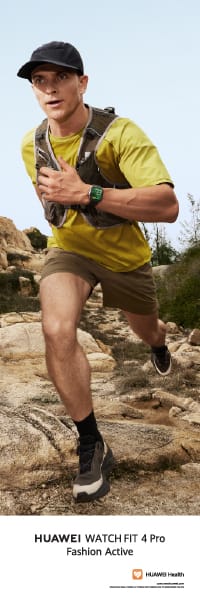Author: Modern Athlete
‹ BackTaking on the Giants
One Hell of an Adventure
Take the Stairs!
Running stairs is a great way to get yourself into shape, and these sessions are by no means limited to runners. In fact, rumour has it that stair sessions are what keep celebrities such as J-Lo in shape! The most important thing to remember is that these sessions must be attempted with great caution. If stairs are not run correctly, you could injure yourself badly. Running stairs takes some practice and concentration, because the slightest misstep and you could end up taking a nasty tumble.
The bottom line is that when adding anything new to your training, it is crucial to add it gradually and to ease into it. If you experience any sharp pains while running stairs, stop immediately and give your body a few days to recover before attempting the workout again. Before any stair workouts, make sure you warm up properly with an easy 20 to 30min jog, then start by walking up and down the stairs a few times before you begin the stair workout.
BENEFITS
There are a number of benefits that you will enjoy by running stairs:
? It’s a great cardio workout and won’t take much to put your lungs into oxygen debt.
? Because you go into debt quickly, you’ll be working hard to keep your rhythm, pace and form, which is great mind training for the last few kilometres of your next race.
? Leg power is a key ingredient in many sports, not just running, so you will certainly benefit in your other disciplines.
GETTING STARTED
1. Find a suitable set of stairs: If you are a Gautenger and live close to Westcliff, then the 400m Westcliff stairs are a good choice. Other options would be a stadium or school in your area (just make sure you get permission first.) If you travel a lot, use the hotel stairs, because most people in a hotel will take the lift, which leaves the stairs traffic-free for your workout.
2. Focus on your form: Running stairs is about building leg strength and power, so focus on leg extension and driving yourself up the stairs with a high knee-lift while pumping your arms. Don’t lean forward from your hips, rather keep an upright posture with a slight lean forward from your ankles, almost like you’re falling into the stairs.
3. What goes up, must come down: Be very careful coming down the stairs, because it’s the descent that can cause damage and injury if too much strain is put on your knees and lower back. When running back down the stairs, try to focus on using your quads and hips to absorb the impact and not your knees. For the first few sessions, rather walk back down. You can start jogging down the stairs once you start getting fitter and more comfortable and confident on the stairs. The walk down is a good recovery before you go bounding back to the top.
It is not necessary to include a stair session every week in your training, but these sessions are a great way to mix things up every now and then by replacing a hill session.
WORKOUTS
Here are some workouts to try, but feel free to let your imagination run wild:
|
|
|
|
|
|
|
|
|
|
|
|
|
|
|
|
|
|
|
|
Ray has run five Comrades Marathons, with a PB of 7:18. He was club captain at Bedfordview Running Club from 2009 to 2011, then became captain of the Bedfordview Performance Squad.
Top Races for the Coming Month!
This week, we give you a sneak peek at upcoming events that you need to add to your racing calendar. Take a look at the events below and make your racing plans.
1. KPMG Durban Relay
The KPMG Durban Relay will be taking place on Saturday, 24 September 2016. This race is a fantastic initiative and is the perfect way to ignite team spirit and put teamwork into action whilst having fun. Running teams of four and walking teams of three will compete in male, female and mixed categories over a 5km flat course along the Umgeni River and the Durban Promenade. This is a great opportunity for corporates, universities, clubs, schools, family and friends to battle it out in order to claim bragging rights as the fastest team in Durban. Come and enjoy a festive atmosphere before, during and after the race with music, entertainment, food, beer and a supervised children's play area. All fitness levels and all ages welcome. Enter now.
3. Aucor Wanderers Road Race
This race is an absolute gem. Winding its way through the beautiful streets of Illovo and Killarney, the Aucor Wanderers Road Race has got something for everyone. Whether you are out to smash your 21km PB or just going for a good 10km or 5km jog, everyone is welcome. Bring the family along for a day of exercise as we cover the streets of Jozi in busy running bodies! Click below to find out more.
3. Dawn to Dusk 2016
Races like these are hard to find but when the Dawn to Dusk Circuit Race comes around, many people know about it. This race is a demanding and very challenging race for all who take part. With a 1km course that winds its way through the Akasia High School, runners must try and complete as many laps of the course as possible with 12 hours. Are you up for the challenge? The record distance for a team entry into this race is 152km. That means you’ll need to do 153 laps in order to break the race record. Will we see you there?
4. Randburg Harriers Street Mile
A street mile… What’s that? Well, bring yourself down to the Randburg Sports Complex as we introduce you to this exciting form of racing. The Randburg Harriers Street Mile challenges runners to run a 1.6km route as fast as they possibly can, however if this event does not appeal to you, you can always take part in the 10km challenge on the day. Click below to find out more about this exciting form of racing!
For more information, click on the button below and view the full Modern Athlete events calendar.
Maximise Your Training Hour
SWIM
EXPERT: Erhard Wolfaardt, professional South African triathlete and former African triathlon champion and u/23 SA triathlon champion.
SESSION: This is a speed session designed to improve lactate threshold and increase strength. I normally use this set towards the end of a hard week. It is only 2.4km, but an effective way to boost your swimming.
WARM-UP:
• 100m backstroke, 200m freestyle, 100m backstroke
• Two sets of 4x50m with 30sec rest in between, and roughly 60sec rest between sets.
MAIN SET: Two rounds of the following:
• 100m at maximum effort, rest 90sec.
• 2x50m at maximum effort, rest 60sec.
• 4x25m at maximum effort, rest 30sec.
Do an easy 200m of mixed strokes before tackling the next round.
Finish with a kick set: 8x50m freestyle kick with 30sec rest. Alternate doing one easy and one hard.
COOL-DOWN: 100m backstroke, 200m freestyle, 100m backstroke
TIP: If you are a stronger swimmer, do three rounds of the main set.
CYCLE
EXPERTS: Malcolm Lange, South African cycling great with 409 major road race victories and Dr. Jeroen Swart, Team Bonitas Coach.
SESSION: Neuromuscular efficiency
One of the key components of top cyclists is the ability to utilise a large group of muscles throughout the pedalling action. This requires strengthening the small muscles such as the hip flexors and calf muscle and also improving the co-ordination of the contraction so that muscles that oppose each other don’t co-contract and waste energy.
WARM-UP: 10min at low intensity at a self selected cadence
MAIN SET:
• 4min at a low cadence (40-50rpm) in a heavy gear. Just enough resistance to need to pull the pedal up on the back of the pedal stroke and up and over into the power phase. You should just be getting breathless at the end of the 4min.
• Follow with 6min at very high cadence (100-120rpm), but against very low resistance. This stimulates the nervous system into developing the correct speed and co-ordination of the contraction.
• Repeat 4 times.
COOL-DOWN: 10min at low intensity and self selected cadence
RUN
EXPERT: Ray Orchison, Captain of the Bedfordview Performance Squad with a Comrades PB of 7:18.
SESSION: The key to getting faster is to develop leg strength and power. A great way to achieve this is to find a short, steep hill (approximately 100m) and do quick short bursts up the incline. This will build leg power and strength while giving you a speed session at the same time.
WARM-UP: Easy 15-20min jog
MAIN SET:
• 8-12 repeats up the hill (100m). Run hard and pump your arms in order to work up the hill, focus on correct running form (slight lean from the ankles into the hill, head up).
• Once at the top, walk or jog very slowly back to the bottom and repeat.
COOL-DOWN: Very easy 15-20min jog
DIY Diet Improvements
Wrapping Up 2016
Check out all the latest news and important info from the world’s biggest, oldest and most famous ultra, the Comrades Marathon. – BY DELAINE COOLS & THAMI VILAKAZI










.png)





